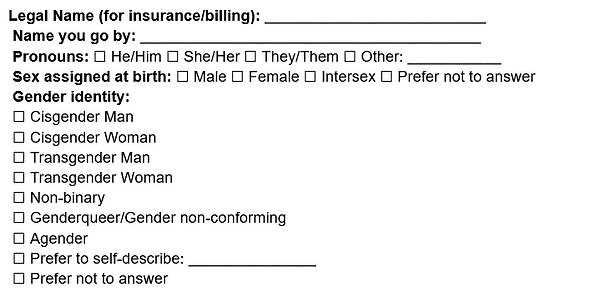
Caring for LGBTQIA+ Patients
We at PhillyHealthCares believe that LGBTQIA+ individuals deserve equal access to affirming and inclusive healthcare. Below are some commonly asked questions about creating more inclusive environments for LGBTQIA+ patients.
"LGBTQIA+ is an acronym that brings together many different gender and sexual identities that often face marginalization across society. The acronym stands for lesbian, gay, bisexual, transgender, queer, questioning, intersex, asexual, and the + holds space for the expanding and new understanding of different parts of the very diverse gender and sexual identities.” -Gender Sexuality Resource Center
How can I ask about a patient's status in a sensitive manner?
Asking about gender and sexual identity should be done with the same clinical respect and neutrality as asking about any other part of a patient's history. It is best to avoid assumptions based on appearance or voice and instead use open-ended, affirming language. Introducing these questions as part of routine care helps normalise the process and creates a safer environment for all patients.
Script Examples
-
"To provide you with the best possible care, may I ask how you identify your gender?"
-
"Which name and pronouns would you like to use?"
-
"Is the gender listed on your chart accurate or would you like to update that?"
How do I ask what somebody's pronouns are?
Misgendering patients with the wrong pronoun can lead to significant psychological distress for trangender and nonbinary people, but this can be avoided by asking for pronouns as a sign of respect. The best approach is to introduce your own pronouns first, then invite the patient to share theirs. This practice is most effective when implemented for all patients, not just those perceived as gender diverse.
Script Examples
-
"Hi, I'm Dr. Xyz. I use she/her pronouns, how about you?"
-
"Before we get started, may I ask what pronouns you use?"
-
"We're working to ensure inclusive care for all our patients. Can I confirm the pronouns you use?"
Sample Inclusive Demographic Form Section

Many offices now collect pronoun information during the intake process, often through demographic forms completed before or during a first visit. To promote inclusiveness, forms should allow patients to self-identify their gender, list their pronouns, and provide both legal name/name assigned at birth and their chosen name that they use in daily life. It is important that all clinical staff are trained to reference this information appropriately during patient interactions and in the medical re cord.
Does insurance generally cover gender affirming care or surgery?
At this time, yes. Most majour US insurance companies, including Medicare and many state Medicaid programs (including Pennsylvania), now recognise gener-affirming care as medicaly necessary and cover services such as hormone therapy, top surgery, and bottom surgery. However, coverage varies by individual plan, and some services, like facial surgery, body contouring, or voice modification may be excluded or considered cosmetic. Patients typically need to meet certain eligibility criteria which may include a diagnosis of gender dysphoria, hormone therapy, and letters of readiness from medical professionals
What are some insurance resources?
-
A4TE Trans Health Project: Helps determine different coverage from different plans
-
Point of Pride: Nonprofit funding option for uninsured or under-insured patients.
What should I do if I don't feel confident providing gender-affirming care?
It is okay to acknowledge limitations, but it is your responsibility to seek education or refer patients to affirming care. Do not leave patients without knowledge of other options. Collaborate with social workers, case managers, or LGBTQIA+ community health centres when needed.
Script Examples
-
"I want to make sure you get the best care possible. Let me connect you with a specialist i trust."
-
I'm still learning in this area, but I'm committed to supporting you and finding the right team to help."
-
"I will stay involved in your care, but let me refer you to a provider with more experience in gender-affirming surgery."
Last Updated by PHC 7/10/25